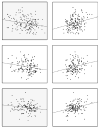Fitness, fatness, cognition, behavior, and academic achievement among overweight children: do cross-sectional associations correspond to exercise trial outcomes?
- PMID: 21281668
- PMCID: PMC3164323
- DOI: 10.1016/j.ypmed.2011.01.020
Fitness, fatness, cognition, behavior, and academic achievement among overweight children: do cross-sectional associations correspond to exercise trial outcomes?
Abstract
Background: This study examined associations of fitness and fatness with cognitive processes, academic achievement, and behavior, independent of demographic factors, at the baseline of an exercise trial.
Methods: Overweight, sedentary but otherwise healthy 7-11 year olds (N=170) participated in a study of health, cognition and achievement in the Augusta, GA area from 2003-2006. Children underwent evaluations of fatness and fitness, psychological assessments of cognition and academic achievement, and behavior ratings by parents and teachers. Partial correlations examined associations of fitness and fatness with cognitive and achievement scores and behavior ratings, controlling for demographic factors.
Results: Fitness was associated with better cognition, achievement and behavior, and fatness with worse scores. Specifically, executive function, mathematics and reading achievement, and parent ratings of child behavior were related to fitness and fatness. Teacher ratings were related to fitness.
Conclusion: These results extend prior studies by providing reliable, standardized measures of cognitive processes, achievement, and behavior in relation to detailed measures of fitness and fatness. However, cross-sectional associations do not necessarily indicate that improving one factor, such as fatness or fitness, will result in improvements in factors that were associated with it. Thus, randomized clinical trials are necessary to determine the effects of interventions.
Copyright © 2011. Published by Elsevier Inc.
Conflict of interest statement
There is no conflict of interest.
Figures

Similar articles
-
Cardiorespiratory Fitness and Muscular Strength as Mediators of the Influence of Fatness on Academic Achievement.J Pediatr. 2017 Aug;187:127-133.e3. doi: 10.1016/j.jpeds.2017.04.037. Epub 2017 May 16. J Pediatr. 2017. PMID: 28526219
-
Classroom-based physical activity, cognition, and academic achievement.Prev Med. 2011 Jun;52 Suppl 1:S36-42. doi: 10.1016/j.ypmed.2011.01.021. Epub 2011 Jan 31. Prev Med. 2011. PMID: 21281666 Review.
-
Physical fitness and academic achievement in third- and fifth-grade students.J Sport Exerc Psychol. 2007 Apr;29(2):239-52. doi: 10.1123/jsep.29.2.239. J Sport Exerc Psychol. 2007. PMID: 17568069
-
Study protocol and rationale of the "Cogni-action project" a cross-sectional and randomized controlled trial about physical activity, brain health, cognition, and educational achievement in schoolchildren.BMC Pediatr. 2019 Jul 26;19(1):260. doi: 10.1186/s12887-019-1639-8. BMC Pediatr. 2019. PMID: 31349791 Free PMC article.
-
Aerobic fitness and academic achievement: A systematic review and meta-analysis.J Sports Sci. 2020 Mar;38(5):582-589. doi: 10.1080/02640414.2020.1720496. Epub 2020 Jan 31. J Sports Sci. 2020. PMID: 32005082
Cited by
-
The Effect of Leisure Time Sport on Executive Functions in Danish 1st Grade Children.Children (Basel). 2022 Sep 23;9(10):1458. doi: 10.3390/children9101458. Children (Basel). 2022. PMID: 36291397 Free PMC article.
-
Cardiovascular fitness and executive functioning in primary school-aged children.Dev Sci. 2021 Mar;24(2):e13019. doi: 10.1111/desc.13019. Epub 2020 Aug 10. Dev Sci. 2021. PMID: 32673418 Free PMC article.
-
Partly randomised, controlled study in children aged 6-10 years to investigate motor and cognitive effects of a 9-week coordination training intervention with concurrent mental tasks.BMJ Open. 2018 May 24;8(5):e021026. doi: 10.1136/bmjopen-2017-021026. BMJ Open. 2018. PMID: 29794099 Free PMC article. Clinical Trial.
-
Cognitive control in preadolescent children with risk factors for metabolic syndrome.Health Psychol. 2015 Mar;34(3):243-52. doi: 10.1037/hea0000114. Epub 2014 Aug 18. Health Psychol. 2015. PMID: 25133829 Free PMC article.
-
Executive Functions Do Not Mediate Prospective Relations between Indices of Physical Activity and Academic Performance: The Active Smarter Kids (ASK) Study.Front Psychol. 2017 Jun 29;8:1088. doi: 10.3389/fpsyg.2017.01088. eCollection 2017. Front Psychol. 2017. PMID: 28706500 Free PMC article.
References
-
- Aktop A. Socioeconomic status, physical fitness, self-concept, attitude toward physical education, and academic achievement of children. Percept Mot Skills. 2010;110:531–546. - PubMed
-
- American College of Sports Medicine. ACSM’s Guidelines for Exercise Testing and Prescription. 6. Lippincott Williams & Wilkins; Baltimore: 2000.
-
- Buck SM, Hillman CH, Castelli DM. The relation of aerobic fitness to Stroop task performance in preadolescent children. Med Sci Sports Exerc. 2008;40:166–172. - PubMed
-
- Castelli DM, Hillman CH, Buck SM, Erwin HE. Physical fitness and academic achievement in third- and fifth-grade students. J Sport Exerc Psychol. 2007;29:239–252. - PubMed

